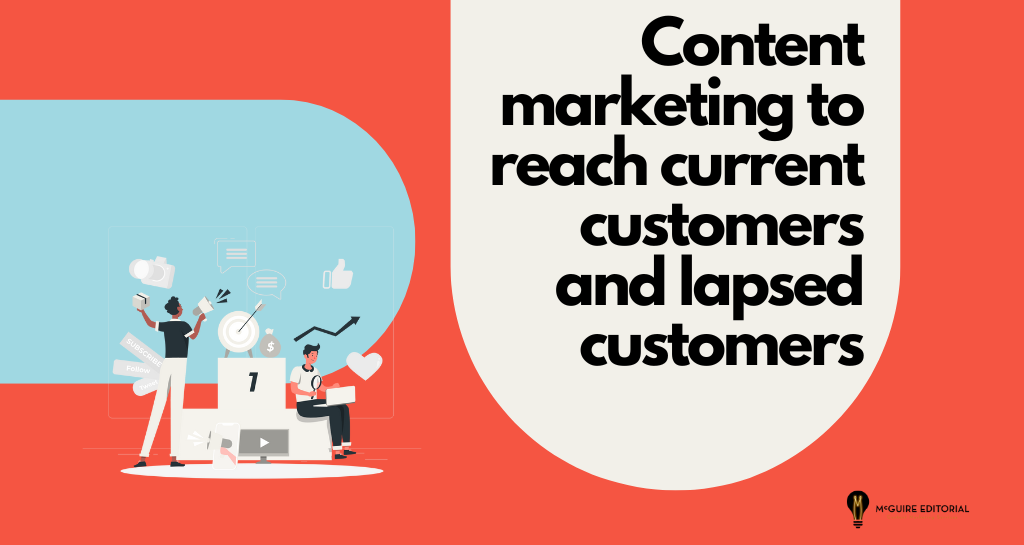But what’s on the other side of the funnel’s spout? An empty void? Is the customer in heaven, limbo or purgatory?
The problem with the sales funnel model is that it doesn’t account for the need to keep engaging with current customers after the sale and, where there is an opportunity to draw them back, with lapsed customers.
If your content calendar ends at the bottom of the traditional sales funnel, it ends too soon. Content marketing is still a viable — even necessary — way to maintain relationships with people who have already gone through to the other side.
[tweetthis]If your content marketing calendar ends at the bottom of the sales funnel, it ends too soon.[/tweetthis]
After all, your customer database is your most valuable asset, and reducing churn is a lot more cost-effective than acquiring new customers. So why wouldn’t you want your content marketing plan to support that goal also?
Sometimes marketers breath a sigh of relief when they convert a customer. They think, “Great, now we can leave this person alone and move on to getting more leads into the funnel.” But focusing on lead generation exclusively may make you miss the bigger opportunity.
Understanding Current Customers
A lot of marketers assume that occasional emails to current customers is enough to keep them engaged, but according to marketing intelligence company Smart Insights, subscribers are more likely to leave if a brand’s website doesn’t offer lots of great content.
What makes someone a current customer? It’s not only about buying. A current customer can be someone who bought one inexpensive product but continued to engage with the brand, perhaps waiting for the right time to buy again.
They become easier to define, however, if you have a subscription-based service. They aren’t necessarily loyal either. You and your team will need to establish a time frame if you want to decide who is likely to be with you for a long time.
Understanding lapsed customers
Lapsed customers are, at the very least, people who have not purchased a product in some time. Maybe it’s someone who stopped their subscription to your SaaS product. Or maybe it’s someone who came to your accounting firm for tax advice every year like clockwork and suddenly misses a year.
But that definition is a little broad, so you’ll need to understand these people before targeting them with content. Don’t be quick to put a time limit on consumer activity, because it can be arbitrary.
Engagement is a better way to measure whether a customer has lapsed. Use analytics to check if your customers are opening newsletters, engaging on social media or reading content. Only customers who are not buying or engaging with your online presence have truly lapsed. If a subscriber is engaging but not purchasing, it simply means they don’t need the product or service at the moment.
If you want to create a time frame for a lapse in engagement and purchasing, tailor it to the product. A SaaS product would have a small window, perhaps only a month or two. For services like insurance consulting or legal retainers, marketers can be more patient.
Using content marketing to keep current customers engaged
Now that you have a better understanding of these segments, you’ll need content to convert current customers to long-time customers and to engage lapsed customers. Current customers need to see the value of sticking with a product or service for a long time. Content marketing allows you to present them with compelling stories that will motivate them to stay.
[tweetthis]Current customers need content that shows the value of sticking with a product or service.[/tweetthis]
An elearning provider could send a case study about a corporation that improved the skills of their millennial employees by giving them access to online courses for several years. Or maybe they could commission a study that compares the outcomes for consistent and inconsistent users of elearning.
Another tactic is “customer education” content that helps them get more value out of the product by helping them become super users. The classic example of this is Arm & Hammer baking soda. For years the brand asked customers to share how they used Arm & Hammer (also a good example of user generated content) and shared the results in a booklet for loyal customers, educating them on an ever-growing list of ways to benefit from the product. That’s a terrific customer retention tactic.
More recently, you’ll see many software companies using drip email campaigns to keep educating customers about features that often get overlooked right away. For example, when you pay for the professional or premium versions of Evernote, you start getting occasional “training” emails to help you understand the full power of the product.
The challenge of engaging lapsed customers
Lapsed customers are more difficult. A well-conceived “win back” email campaign sprinkled with discounts can be effective.
But that doesn’t mean content marketing doesn’t also have a role. The open rates for lapsed customers are going to be lower, so you need to think about how to provide them with content that is different than what you would send to potential or existing customers.
Start by understanding why they stopped using your product in the first place and then speak to that resistance. (Buyer personas can help here.) Don’t send stories showing the benefits of being with your brand. It’s too obvious and salesy a tactic.
Instead, you’re going to have to wow them with something very high-quality such as in-depth research or the show notes from your webinars.
[tweetthis]Content marketing targeting lapsed customers has to wow them with very high-quality.[/tweetthis]
The approach here is to win them back by making them miss you. If you have high-value content assets behind registration forms, this is a group you might want to send those assets to without any restrictions. You’ll want a killer subject line, some A/B testing of that subject line and strong call to action at the end asking them to reengage.
Remember, the essence of content marketing is to help people with their problems. Lapsed customers for some reason have decided that you don’t help them quite enough to keep up the relationship. Content marketing can help them think again by showing your authority and expertise.

Joseph Rauch
Guest Author


